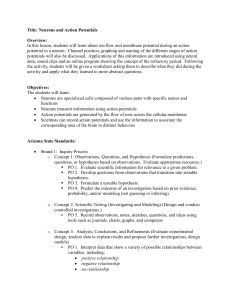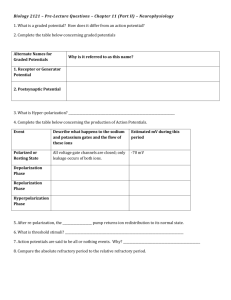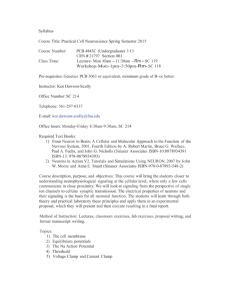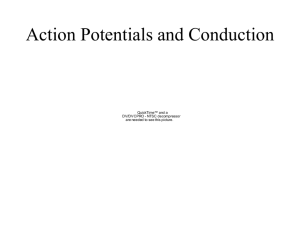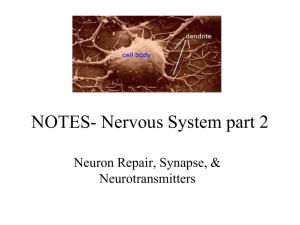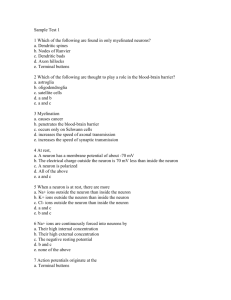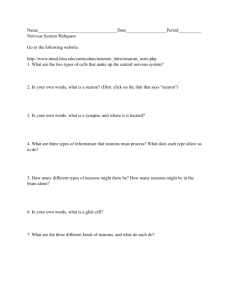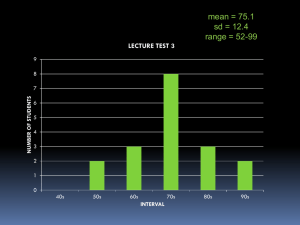Neuron Function Study Guide
advertisement
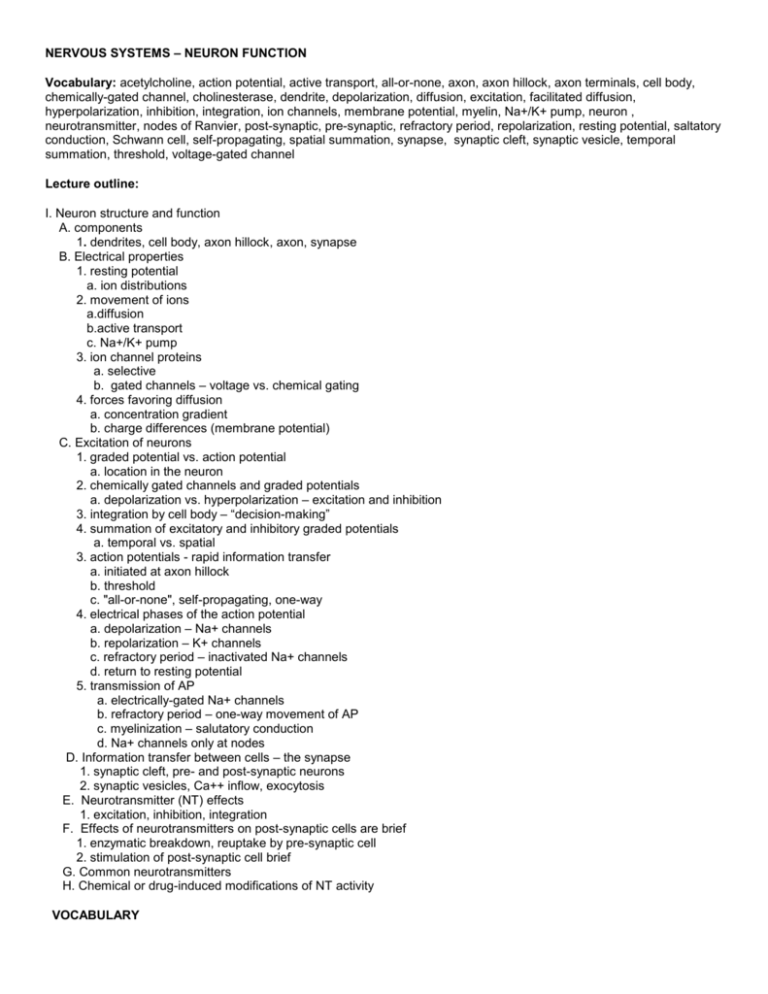
NERVOUS SYSTEMS – NEURON FUNCTION Vocabulary: acetylcholine, action potential, active transport, all-or-none, axon, axon hillock, axon terminals, cell body, chemically-gated channel, cholinesterase, dendrite, depolarization, diffusion, excitation, facilitated diffusion, hyperpolarization, inhibition, integration, ion channels, membrane potential, myelin, Na+/K+ pump, neuron , neurotransmitter, nodes of Ranvier, post-synaptic, pre-synaptic, refractory period, repolarization, resting potential, saltatory conduction, Schwann cell, self-propagating, spatial summation, synapse, synaptic cleft, synaptic vesicle, temporal summation, threshold, voltage-gated channel Lecture outline: I. Neuron structure and function A. components 1. dendrites, cell body, axon hillock, axon, synapse B. Electrical properties 1. resting potential a. ion distributions 2. movement of ions a.diffusion b.active transport c. Na+/K+ pump 3. ion channel proteins a. selective b. gated channels – voltage vs. chemical gating 4. forces favoring diffusion a. concentration gradient b. charge differences (membrane potential) C. Excitation of neurons 1. graded potential vs. action potential a. location in the neuron 2. chemically gated channels and graded potentials a. depolarization vs. hyperpolarization – excitation and inhibition 3. integration by cell body – “decision-making” 4. summation of excitatory and inhibitory graded potentials a. temporal vs. spatial 3. action potentials - rapid information transfer a. initiated at axon hillock b. threshold c. "all-or-none", self-propagating, one-way 4. electrical phases of the action potential a. depolarization – Na+ channels b. repolarization – K+ channels c. refractory period – inactivated Na+ channels d. return to resting potential 5. transmission of AP a. electrically-gated Na+ channels b. refractory period – one-way movement of AP c. myelinization – salutatory conduction d. Na+ channels only at nodes D. Information transfer between cells – the synapse 1. synaptic cleft, pre- and post-synaptic neurons 2. synaptic vesicles, Ca++ inflow, exocytosis E. Neurotransmitter (NT) effects 1. excitation, inhibition, integration F. Effects of neurotransmitters on post-synaptic cells are brief 1. enzymatic breakdown, reuptake by pre-synaptic cell 2. stimulation of post-synaptic cell brief G. Common neurotransmitters H. Chemical or drug-induced modifications of NT activity VOCABULARY Study Questions What are the components of a typical neuron? What processes occur in what areas? Resting potentials vs. graded potentials vs. action potentials – where do they occur and how? How are ion channels and ion movement involved? What ions move and when? What is the effect on the membrane potential? What are gated ion channels? Where are they, how do they work? How are they involved in graded vs. action potentials? What happens during depolarization, repolarization, and hyperpolarization? How? What is the effect on neuron function? How is a graded potential converted to an action potential? Where? What is summation? How does it work? Where does it occur? What are the differences between temporal and spatial summation? How does transmission of action potential affect the electrical properties of the axon membrane and ion movement across it? What is the role of the Na+/K+ pump in neuron function? How can the velocity of action potentials be increased? How does synaptic transmission occur? How is information passed between neurons, or between a neuron and muscle cell? What is the role of neurotransmitters? How do excitatory vs inhibitory neurotransmitters differ in their function? How is the period of neurotransmitter activity typically limited? By what mechanisms? How do drugs or poisons modify the effects of neurotransmitters?

